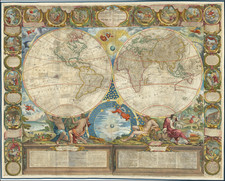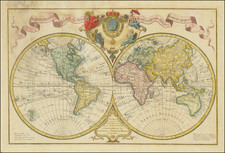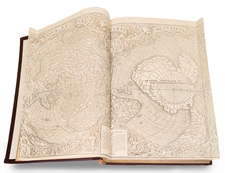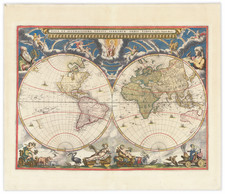A fine example of Paolo Forlani's rare oval map of the world, the first map of the world by Forlani, which is based on Giacomo Gastaldi's 1546 oval shaped map of the world.
Forlani relies greatly on the work of Gastaldi for the essential world outline and for virtually all the geographical detail. The only major deviation from Gastaldi's world map is in
North America,
where Forlani omitted the clumps of trees and inserted imaginary or reported towns and mountain ranges. The map includes several landmark firsts, including the first reference to "
Canada
" and "Saguenai" on a printed map. North America is depicted as joining
Asia
. The 7 Cities of Cibola (La Sete Ctia) are named, with Cipola located to the South. Of the eastern place names, only Florida surives.
Until the printing of Forlani's maps in the 1560s, the name
Canada
had appeared on only a few manuscript depictions of the country. The Forlani maps popularized use of the name
Canada
in 16th-Century
Europe
. Created just a few decades after French explorer Jacques Cartier's historic voyages up the St. Lawrence River, the 1562 map also includes landmark references to the Arctic Ocean ("Oceano Settentrionale"), "Tiera de Laborador," "Stadacone" (the Iroquois settlement at the future Quebec City), and "Saguenai. Forlani's first world map is among the most influential World maps of the 16th Century and was likely responsible for a great leap forward in the depiction of the world on a printed map. Prior to the issuance of Forlani's World Map, the cartography depicted was available to the educated world only in Gastaldi's extremely rare wall map and his tiny
Geografia.
Forlani took great care to decorate his work with two compass roses, Venetian galleys and other sailing ships, as well as fantastic sea creatures prowling the
Atlantic Ocean
. These trademark embellishments were among the earliest to appear on printed maps and were one of the primary factors that influenced and popularized the inclusion of such decorative images on printed maps for the next 200+ years.
The Ventian mapmaker Paolo Forlani created four world maps, each issued in collaboration with other Italian mapmakers. Today, these maps typically survive only in very rare composite atlases known as Lafreri Atlases (named for Antonio Lafreri of Rome, who added a title page to some of these atlases, although no two known examples have an identical set of maps). The present map is the 2nd of 5 states of the map, with the 1st state issued by Forlani in 1560. There is no title on the map, but the text in the left corners ascribes authorship to Paolo Forlani and identifies the publisher as Ioan Francesco Camocio.
The last example of the Gastaldi map to appear at a public sale was in 1999 (Sothebys), where it made a price of nearly $250,000. No example of this 1st of the 4 Forlani World maps has been sold at auction in the past 30 years. By contrast, Forlani's third map,
Univesale Descrittione Di Tutta La Terra Conosciuta Fin Qui, has appeared several times at auction in the past 30 years. Forlani 1 can truly be considered one of the rarest and most influential world maps of the 16th Century which is potentially obtainable by collectors; albeit that at this point, its appearance on the market has been limited in recent years to examples still bound into Lafreri atlases.
Paolo Forlani (fl. ca. 1560-1571) was a prolific map engraver based in Venice. All that is known of his life are his surviving maps and prints, of which there are almost 100 (185 with later states included in the total). He also produced a globe and two town books. It is likely he came from Verona and that he died in Venice in the mid-1570s, possibly of the plague.










![World [Rand, McNally & Company's Indexed Atlas of the World]](https://storage.googleapis.com/raremaps/img/small/100314.jpg)



